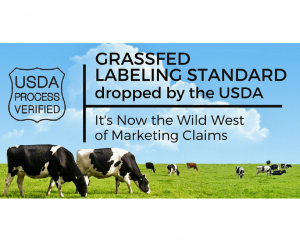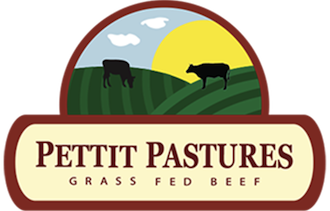Beware of Beef Labels

Grass-fed or Grass Finished Beef?
As the public has become more aware that “grass-fed” beef has greater health benefits than the “feedlot” beef typically found in supermarkets and restaurants, advertising word games have begun. In fact, “grass-fed beef” is starting to appear in many supermarkets and even fast food restaurants. But is it really?
First of all, let’s talk about the grass-fed benefits. According to Jo Robinson, the author and investigative journalist from eatwild.com, meat from grass-fed animals has 2 – 4 times more omega-3 fatty acids than meat from grain- fed animals. Omega-3s are the “good fats” usually associated with seafood that play a vital role in every cell and system in your body. When cattle are taken off omega-3 rich grass and shipped to a feedlot to be fattened on grain, the supply of omega-3s diminishes day by day. It’s down to about 15% in 4 months time.
Jo also reports that meat from animals that live their full lives on pasture have 3 – 5 times more conjugated linoleic acid (CLA) than products from animals fed conventional diets. CLA is another type of healthy fat and meat products from grass-fed ruminants are the richest known source of CLA. Finally, the vitamin E level is also about 4 times higher than found in the meats of grain-fed animals.
So, the reported health benefits of grass-fed beef only make it to the consumer if the animal is also “grass finished”. That wording is rarely identified on the label. “Finishing” refers to the last months of their lives when beeves are through growing larger bones and muscles, and are finally adding on fat.
Virtually all cattle are free range or grass-fed during the first 6 to 9 months of their lives, but those last months – the finishing months – have a dramatic effect on the nutritional properties of the meat. “Grass-fed grass finished beef” or 100% Grass-fed implies that the only feed the animal has EVER had is grass and hay, not grains. From a health perspective, that is the ideal.
In fact it is virtually impossible to tell if the beef you are buying in the grocery store is even a product of the United States. The Tariff Act of 1930 requires imported beef to bear a label denoting the foreign country-of-origin of the beef all the way to the consumer, unless the beef undergoes a substantial transformation in the United States. Unfortunately the Secretary of Agriculture disagrees, arguing in documents that imported beef is to be deemed and treated as domestic beef so long as the importing country’s food safety standards are equivalent to U.S. standards. Consequently, the Secretary allows multinational meatpackers to label imported beef as “Products of the USA” even if the imported beef receives only minor processing, such as unwrapping and rewrapping the package.
Unfortunately, as of today, there is no legal requirement that a product labeled as “grass-fed” is from a grass finished animal or that beef labeled Product of the USA was actually born, raised, or even processed in the USA. One that was raised on grass and finished on corn feed can technically still be called grass-fed and one that lived it’s entire life and was even processed in a foreign country can be labeled Product of the USA. That’s totally misleading the public, but much more lucrative for the meat packers.
So the bottom line is that if you are seeking grass-fed beef for nutritional reasons, you need to confirm that the animal was also grass finished and born, raised, and processed in the USA. That is the only way to be confident you are buying the quality of Beef you are expecting.
That’s virtually impossible to do at a grocery store, but easy to confirm when you know your farmer and can even visit the farm
We welcome your questions and your visit. Know your farmer, know your food!

